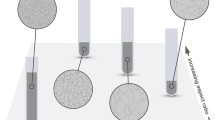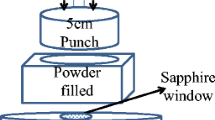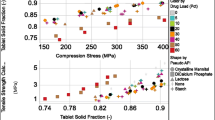Abstract
Purpose
There has been increasing interest in the last few years especially within the pharmaceutical industry towards continuous powder blending. In this paper, the effects of different design and operating parameters are investigated, which include blade speed, shaft angle, weir height, fill level, blade angle, and blade width.
Method
The projection to latent structures regression is introduced to elucidate the significance of these factors on the two key indices of continuous blending performance, the local blending rate and the mean axial velocity.
Results
Shaft angle and blade speed are the two most influential factors pointing to a blending improvement strategy. The proposed strategy is examined using an experimental setup for the production of pharmaceutical powder mixtures.








Similar content being viewed by others
References
Williams JC. Continuous mixing of solids. A review. Powder Techn. 1976;15(2):237–43.
Danckwerts PV. Continuous flow systems: distribution of residence times. Chem Eng Sci. 1953;2(1):1–13.
Gao Y, Muzzio F, Ierapetritou M. Characterization of feeder effects on continuous solid mixing using Fourier series analysis. AICHE J. 2011;57(5):1144–53.
Weinekötter R, Reh L. Continuous mixing of fine particles. Part. Part. Syst. Char. 1995;12(1):46–53.
Gao Y, Vanarase A, Muzzio F, Ierapetritou M. Characterizing continuous powder mixing using residence time distribution. Chem Eng Sci. 2011;66(3):417–25.
Williams JC, Richardson R. The continuous mixing of segregating particles. Powder Technol. 1982;33(1):5–16.
Pernenkil L, Cooney CL. A review on the continuous blending of powders. Chem Eng Sci. 2006;61(2):720–42.
Gao Y, Ierapetritou M, Muzzio F. Periodic section modeling of convective continuous powder mixing processes. AICHE J. 2012;58(1):69–78.
Laurent BFC, Bridgwater J. Influence of agitator design on powder flow. Chem Eng Sci. 2002;57(18):3781–93.
Marikh K, Berthiaux H, Gatumel C, Mizonov V, Barantseva E. Influence of stirrer type on mixture homogeneity in continuous powder mixing: a model case and a pharmaceutical case. Chem Eng Res Des. 2008;86(9):1027–37.
Jones JR, Parker DJ, Bridgwater J. Axial mixing in a ploughshare mixer. Powder Technol. 2007;178(2):73–86.
Portillo PM, Ierapetritou MG, Muzzio FJ. Effects of rotation rate, mixing angle, and cohesion in two continuous powder mixers—a statistical approach. Powder Technol. 2009;194(3):217–27.
Vanarase AU, Muzzio FJ. Effect of operating conditions and design parameters in a continuous powder mixer. Powder Technol. 2011;208(1):26–36.
Portillo PM, Vanarase AU, Ingram A, Seville JK, Ierapetritou MG, Muzzio FJ. Investigation of the effect of impeller rotation rate, powder flow rate, and cohesion on powder flow behavior in a continuous blender using PEPT. Chem Eng Sci. 2010;65(21):5658–68.
Zhou YC, Yu AB, Stewart RL, Bridgwater J. Microdynamic analysis of the particle flow in a cylindrical bladed mixer. Chem Eng Sci. 2004;59(6):1343–64.
Arratia PE, N-h D, Muzzio FJ, Godbole P, Reynolds S. A study of the mixing and segregation mechanisms in the Bohle Tote blender via DEM simulations. Powder Technol. 2006;164(1):50–7.
Brone D, Muzzio FJ. Enhanced mixing in double-cone blenders. Powder Technol. 2000;110(3):179–89.
Wightman C, Muzzio FJ. Mixing of granular material in a drum mixer undergoing rotational and rocking motions I. Uniform particles. Powder Tech. 1998;98(2):113–24.
Gao Y, Ierapetritou M, Muzzio F. Investigation on the effect of blade patterns on continuous solid mixing performance. Can J Chem Eng. 2011;89(5):969–84.
Portillo P, Muzzio FJ, Ierapetritou MG. Hybrid DEM-compartment modeling approach for granular mixing. AICHE J. 2007;53(1):119–28.
Sarkar A, Wassgren C. Continuous blending of cohesive granular material. Chem Eng Sci. 2010;65(21):5687–98.
Sarkar A, Wassgren CR. Simulation of a continuous granular mixer: effect of operating conditions on flow and mixing. Chem Eng Sci. 2009;64(11):2672–82.
Mindlin RD. Compliance of elastic bodies in contact. J Appl Mech. 1949;71:259–68.
Bertrand F, Leclaire LA, Levecque G. DEM-based models for the mixing of granular materials. Chem Eng Sci. 2005;60(8–9):2517–31.
Dubey A, Sarkar A, Ierapetritou M, Wassgren CR, Muzzio FJ. Computational approaches for studying the granular dynamics of continuous blending processes, 1—DEM based methods. Macromol Mater Eng. 2011;296(3–4):290–307.
Portillo PM, Ierapetritou MG, Muzzio FJ. Characterization of continuous convective powder mixing processes. Powder Technol. 2008;182(3):368–78.
Abdi H. Partial least squares regression and projection on latent structures regression (PLS regression). Wiley Interdisciplinary Rev: Computational Statistics. 2010;2(1):97–106.
Stein M. Large sample properties of simulations using Latin hypercube sampling. Technometrics. 1987;29(2):143–51.
Vanarase AU, Alcalà M, Jerez Rozo JI, Muzzio FJ, Romañach RJ. Real-time monitoring of drug concentration in a continuous powder mixing process using NIR spectroscopy. Chem Eng Sci. 2010;65(21):5728–33.
Wold S, Sjöström M, Eriksson L. PLS-regression: a basic tool of chemometrics. Chemom Intell Lab Syst. 2001;58(2):109–30.
Lopes VV, Menezes JC. Inferential sensor design in the presence of missing data: a case study. Chemom Intell Lab Syst. 2005;78(1–2):1–10.
Gao Y, Muzzio FJ, Ierapetritou MG. Optimizing continuous powder mixing processes using periodic section modeling. Chem Eng Sci. 2012;80:70–80.
Acknowledgments
This work is supported by the National Science Foundation Engineering Research Center on Structured Organic Particulate Systems, through grant NSF-ECC 0540855 and by grant NSF-0504497. The authors are thankful to Dr. Salvador G. Muñoz in Pfizer for the PLS Seminar in Purdue University. The authors would also like to thank Juan Osorio, Dr. Patricia M. Portillo, and Dr. Atul Dubey for their help on experimental suggestions and Dr. Douglas B. Hausner for editing this manuscript.
Author information
Authors and Affiliations
Corresponding author
Appendix
Appendix
Details of the 64 simulations. The six factors are normalized with lower bound 0 and upper bound 1. Notice that the negative values of axial velocity indicate net backward flow in the specific conditions.
Rights and permissions
About this article
Cite this article
Gao, Y., Boukouvala, F., Engisch, W. et al. Improving Continuous Powder Blending Performance Using Projection to Latent Structures Regression. J Pharm Innov 8, 99–110 (2013). https://doi.org/10.1007/s12247-013-9152-3
Published:
Issue Date:
DOI: https://doi.org/10.1007/s12247-013-9152-3




